How to Build a Communication Strategy
In the dynamic realm of Public Relations (PR), where the landscape evolves rapidly, a well-crafted communication strategy is the linchpin that separates successful campaigns from the noise. Navigating the intricacies of modern PR requires a meticulous approach to communication, one that not only aligns with organizational goals but also resonates with diverse stakeholders. In this comprehensive guide, we embark on a journey to unveil the key principles and actionable steps in creating a robust communication strategy that elevates your PR endeavors to new heights.
Know Your Objectives
At the heart of every effective communication strategy lies a crystal-clear understanding of objectives. Begin by aligning your communication goals with broader organizational objectives. Whether it's fostering brand awareness, managing a crisis, or launching a new product, clarity on the 'why' sets the tone for all subsequent communication efforts.
Tip: Conduct a thorough SWOT analysis to identify strengths, weaknesses, opportunities, and threats, providing a foundation for your communication objectives.
Clarity is Key
Crafting impactful key messages is the cornerstone of any successful communication strategy. These messages should encapsulate your brand's values, resonate with your target audience, and remain consistent across all communication channels. The clarity of your key messages ensures a unified narrative that reinforces your brand identity.
Tip: Test your key messages internally to ensure they resonate with different departments and stakeholders before rolling them out externally.
Tailor Your Approach
Not all stakeholders are created equal, and a one-size-fits-all communication approach is bound to fall short. Effective communication strategies hinge on understanding your diverse audience segments. Conduct audience segmentation to tailor your messages, ensuring they address the unique needs and preferences of each group.
Tip: Develop audience personas to create a nuanced understanding of your target demographics, enabling personalized communication strategies.
Be Where Your Audience Is
The communication landscape is vast, encompassing traditional and digital channels. Identifying the channels most frequented by your audience is pivotal. While press releases and media outreach remain essential, integrating social media, email campaigns, and even podcast appearances can amplify your reach.
Tip: Regularly assess the performance of each channel and adjust your strategy based on engagement metrics to optimize your communication mix.
Capitalize on Opportunities
Timing is everything in PR. Craft a timeline that aligns with industry events, product launches, or relevant news cycles. Being strategic about when and how you release information can significantly impact its reception and reach.
Tip: Develop a content calendar that integrates key organizational milestones, industry events, and seasonality to guide the timing of your communications.
Be Prepared
No communication strategy is complete without a robust crisis communication plan. Anticipate potential issues, have a predefined crisis team, and establish communication protocols. Being transparent and proactive during crises can preserve trust and mitigate reputational damage.
Tip: Conduct regular crisis simulations to ensure your team is well-prepared to respond swiftly and effectively during challenging times.
Quantify Impact
Effectiveness is gauged through measurable outcomes. Define key performance indicators (KPIs) aligned with your communication objectives. Whether it's media coverage, social media engagement, or website traffic, a data-driven approach ensures continual improvement.
Tip: Leverage analytics tools to track KPIs and regularly evaluate your communication strategy's impact against predefined benchmarks.
Foster a Culture of Communication
Effective communication is a team effort. Empower your team with the necessary tools and training to be effective communicators. Cultivate a culture that values transparent and open communication at all levels of the organization.
Tip: Conduct regular training sessions and workshops to enhance communication skills within your team, fostering a collaborative environment.
Continual Improvement
A successful communication strategy is a dynamic entity that evolves with changing landscapes. Establish a feedback mechanism that encourages continuous improvement. Regularly solicit feedback from stakeholders, analyze results, and iterate your strategy accordingly.
Tip: Use post-campaign evaluations, surveys, and stakeholder interviews to gather qualitative feedback and insights for refinement.
Conclusion
In the ever-evolving world of PR, strategic communication is both an art and a science. A well-defined communication strategy serves as a roadmap, guiding your PR efforts towards success. From setting clear objectives to defining key messages, understanding your audience, and integrating crisis communication, each facet contributes to a holistic and effective communication approach. Remember, the journey doesn't end; it evolves with the ever-changing dynamics of your organization and the broader PR landscape. Embrace the art of strategic communication, and watch as your PR efforts not only navigate but thrive in the complex web of modern communication.

